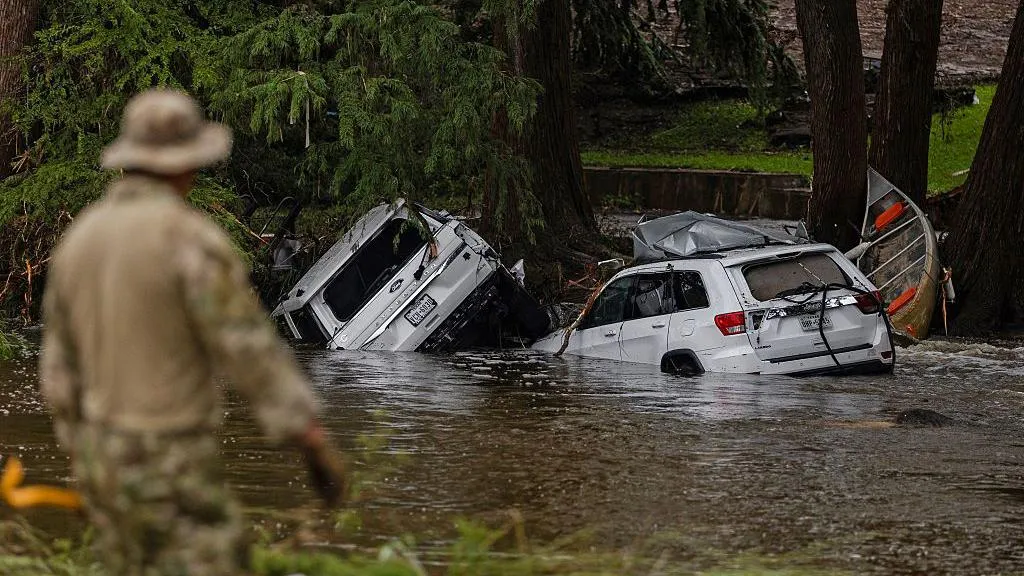‘Lives are at stake:’ Deadly Texas storms put spotlight on Trump’s weather agency cuts

Deadly storms over the 4 July holiday ravaged Texas’ Hill Country with several months’ worth of rain in a few hours, leaving behind mangled trees, swaths of deep mud and heartbreak over hundreds lost or missing.
They also renewed focus on the US government’s ability to warn and protect residents from weather catastrophes.
The intense rainfall and flash floods are the deadliest weather disaster in the US since President Donald Trump’s administration conducted mass staff cuts at two key weather and climate agencies: the National Oceanic and Atmospheric Organisation (NOAA) and its subsidiary, the National Weather Service (NWS).
While experts say the National Weather Service issued alerts in a timely manner over the weekend, the deadly incident carries warnings about what could happen if the NWS and NOAA are not properly staffed and funded in the future.
“The Weather Service did a good job with the information you had here. I don’t think the staffing cuts contributed to this,” said Andy Hazelton, a climate scientist who was laid off from NOAA where he modelled hurricane paths.
“But this is the kind of event we can see more of if the cuts to NOAA continue, if you make the models worse or have the staffing levels lower.”
The agency already has taken a significant hit.
Since February, the weather service has lost about 600 staff through a combination of firings, early retirements, and deferred resignations, said Tom Fahy, legislative director of the National Weather Service Employees Organisation.
Those cuts struck every corner of the agency, said Mr Fahy, from meteorologists to technical specialists to hydrologists, who specialise in flooding.
“We lost a full spectrum of the employees and the brainpower for the National Weather Services,” he said.
Several offices nationally are operating far below traditional staffing levels for meteorologists, Mr Fahy told .
Typically, an NWS office has at least 13 such scientists on their staff, he said. Yet offices in Goodland, Kansas and Hanford, California each have a 61.5% vacancy rate for meteorologists, according to the NWSEO union data. The office in Amarillo, Texas, has a 30.77% vacancy rate for meteorologists, and Rapid City, South Dakota was at 46.15%.
“Staffing has to be increased, we have to do this across the country, we need more individuals to do this,” Mr Fahy said. “You can’t run a weather forecast office on a bare bones operation. Too many things are at stake, too many lives at are at stake.”
The San Antonio office, which played a leading role in forecasting last week’s deadly rainstorms, has about an 18% vacancy rate, according to a tally of open roles on its website.
But it had “additional forecasters on duty during the catastrophic flooding event”, NWS spokeswoman Erica Grow Cei said in a statement.
Limited staffing would not immediately spell disaster anyhow, according to a volunteer who works with the San Antonio weather office to disseminate alerts in his community.
Next:EU and Mexico criticise Trump’s proposed 30% tariff
Related Reading
- Trump hits the road to sell economic message and counter cost of living concerns
- Alina Habba resigns after court disqualified her from being New Jersey’s top prosecutor
- Trump criticises Democrat he pardoned over not switching political parties
- Venezuela condemns Trump airspace closure warning
- Who is Trump’s ‘drone guy’ Dan Driscoll, taking key role in Ukraine talks?
- Pentagon to review Senator Mark Kelly misconduct allegations after video to troops
- US military officials in Ukraine for talks on ending war
- Congress approves bill to release Epstein files that will head to Trump’s desk
- ‘We’re just going to go through this again’: Americans fear second government shutdown
- Syria to join US-led coalition to defeat IS group after Trump meeting
